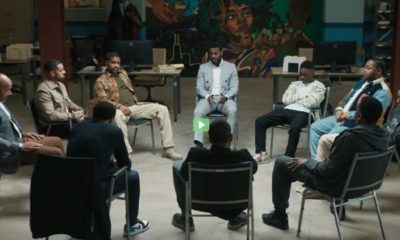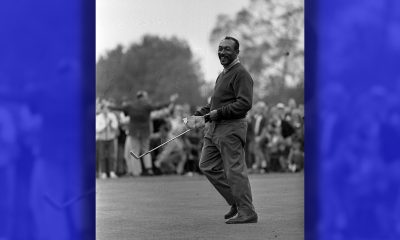Black History
Black History Month and Nashville’s involvement in the Civil Rights Movement
NASHVILLE PRIDE — Make no mistake, Black History Month educates, honors, and acknowledges the achievements and accomplishments of people of African descent.
By William T. Robinson, Jr.
Make no mistake, Black History Month educates, honors, and acknowledges the achievements and accomplishments of people of African descent. Black History Months detail the struggle and perseverance of Blacks throughout this country as well as the world. Here in this country it is expressed in greater detail in an effort to make this country representative of the values and morals that could only make us more inclusive and open to offering justice, acceptance, and opportunities to all citizens.
We know seeking justice and equality has been an uphill fight for African Americans, especially when you look at the disproportionate distribution of wealth as well as systemic racism plaguing people of color. The fight by those seeking to oppress people of color is uncovered during this month and one can better understand why we are feared more than hated. Apparently, fear of our greatness is the impetus that harbors such great animosity and disdain for many African Americans by those who work so diligently to oppress us.
The quest to bring true equality, justice and respect for Blacks can only be brought about by honestly exposing our true history, however uncomfortable it may be for many. It is only when you make an honest effort to study the true history of Blacks in this country and the world that you have a better understanding of the status quo.
Learning the truth will help dismiss the lies and negative stereotypes contributing to false detrimental narratives objectifying people of color. While Black history is history and should be taught throughout the year, this month is an attempt to educate the world on the profound greatness, beauty, and intellect of Blacks.
There are cities like Nashville that have played an indelible role in Black history. Nashville should be proud of the role African Americans and their supporters played in advocating and fighting for civil rights, equality, and racial justice for all Americans. Students from Nashville’s four HBCUs, Black high schools students, churches, pastors, attorneys, community leaders, Black communities and concerned White supporters rallied together to fight inequality and racial injustice. Nashville served as a model for other cities, training students in nonviolent civil disobedience.Nashville’s involvement in the Civil Rights Movement is legendary. Ironically, you must go to cities like Memphis, Birmingham, Montgomery, Selma and Atlanta to visit museums that adequately and truly honor and give credence to the efforts of people in the forefront of the Civil Rights Movement from our city.
Can we honestly say Nashville has paid due diligence to the freedom fighters from TSU whowere kicked out of the university when they put their lives on the line riding on interstate buses throughout a segregated hate inundated South? They were later honored and given honorary degrees, but is that enough for putting their lives on the line to bring about change we all enjoy?
I can think of no other place that has so many people who should be honored than those in Nashville. Yet we don’t have a Civil Rights Museum. You must go to other cities to understand the full extent of Nashville’s role in the Civil Rights Movement. Many Nashvillians feel this is a slap in the face, especially for the heroic icons still living in this city. Many African Americans here are adamant in their feelings that Nashville can do much more to honor the major participants of the Civil Rights Movement.
While it is good that we have the African American Museum being built in Nashville, many Black Nashvillians feel we would be better served to extensively honor and memorialize the legends in our struggle for civil rights and equality first. Better yet, why couldn’t the pending Black museum being built be named the African Museum for Civil Rights and African American Music (food for thought). I am not attempting to dilute the role Nashville played historically by contributing to music, but many African American Nashvillians consider our role in the Civil Rights movement far greater.
Respectfully, I apologize to those courageous participants in Nashville who put their lives on the line—those who were relentless warriors for freedom and equality for all who may feel slighted. No doubt, these crusaders deserve so much more. A room in Nashville’s downtown public library (The Civil Rights Room) and a restaurant recreating the Civil Rights Sit-In lunch counter site is sufficient for some; however, this city could do better when compared to other cities when honoring Nashville’s Civil Rights participants and icons.
Activism
Oakland Post: Week of April 17 – 23, 2024
The printed Weekly Edition of the Oakland Post: Week of April 17 – 23, 2024

To enlarge your view of this issue, use the slider, magnifying glass icon or full page icon in the lower right corner of the browser window. ![]()
Black History
Matthew Henson: Explorer Extraordinaire
Matthew Henson, a trailblazing explorer who overcame countless obstacles to leave an incredible mark on history. Born on August 8, 1866, in Charles County, Maryland, his journey is a testament to the power of determination and the spirit of adventure.

By Tamara Shiloh
Matthew Henson, a trailblazing explorer who overcame countless obstacles to leave an incredible mark on history. Born on August 8, 1866, in Charles County, Maryland, his journey is a testament to the power of determination and the spirit of adventure.
Henson’s life began amidst the backdrop of post-Civil War America, where opportunities for African Americans were scarce. From a young age, he possessed an insatiable curiosity about the world beyond his small town. At the age of 12, he embarked on a journey that would change the course of his life forever when he joined a merchant ship as a cabin boy.
His most famous expedition was his journey to the Arctic with renowned explorer Robert E. Peary. In 1887, Henson joined Peary’s crew as a seaman and quickly proved himself to be invaluable with his skills as a navigator and craftsman. Over the course of several expeditions, Matthew endured extreme cold, treacherous terrain, and grueling conditions as he and Peary sought to reach the elusive North Pole.
In 1908–09, Peary set out on his eighth attempt to reach the North Pole. It was a big expedition, with Peary planning to leave supplies along the way. When he and Henson boarded their ship, the Roosevelt, leaving Greenland on August 18, 1909, they were joined by a large group. This included 22 Inuit men, 17 Inuit women, 10 children, 246 dogs, 70 tons of whale meat, blubber from 50 walruses, hunting gear, and tons of coal.
In February, Henson and Peary left their anchored ship at Ellesmere Island’s Cape Sheridan, along with the Inuit men and 130 dogs. They worked together to set up a trail and supplies along the way to the Pole.
Peary picked Henson and four Inuit people to join him in the final push to the Pole. However, before they reached their destination, Peary couldn’t walk anymore and had to ride in a dog sled. He sent Henson ahead to scout the way. In a later interview with a newspaper, Henson recalled being in the lead and realizing they had gone too far. The group turned back, and Henson noticed his footprints helped guide them to their destination. At that location, Henson planted the American flag.
Henson’s legacy extends far beyond his expeditions to the Arctic. He shattered racial barriers in the world of exploration and inspired countless individuals, regardless of race, to dream big and pursue their passions. In 1937, he was finally recognized for his achievements when he was inducted into The Explorers Club, an organization dedicated to promoting scientific exploration and field research.
Matthew Henson died in the Bronx, New York, on March 9, 1955, at the age of 88.
Art
Marin County: A Snapshot of California’s Black History Is on Display
The Marin County Office of Education, located at 1111 Las Gallinas Ave in San Rafael, will host the extraordinary exhibit, “The Legacy of Marin City: A California Black History Story (1942-1960),” from Feb. 1 to May 31, 2024. The interactive, historical, and immersive exhibit featuring memorabilia from Black shipyard workers who migrated from the South to the West Coast to work at the Marinship shipyard will provide an enriching experience for students and school staff. Community organizations will also be invited to tour the exhibit.

By Post Staff
The Marin County Office of Education, located at 1111 Las Gallinas Ave in San Rafael, will host the extraordinary exhibit, “The Legacy of Marin City: A California Black History Story (1942-1960),” from Feb. 1 to May 31, 2024.
The interactive, historical, and immersive exhibit featuring memorabilia from Black shipyard workers who migrated from the South to the West Coast to work at the Marinship shipyard will provide an enriching experience for students and school staff. Community organizations will also be invited to tour the exhibit.
All will have the opportunity to visit and be guided by its curator Felecia Gaston.
The exhibit will include photographs, articles and artifacts about the Black experience in Marin City from 1942 to 1960 from the Felecia Gaston Collection, the Anne T. Kent California Room Collection, The Ruth Marion and Pirkle Jones Collection, The Bancroft Library, and the Daniel Ruark Collection.
It also features contemporary original artwork by Chuck D of the Rock and Roll Hall of Fame group Public Enemy, clay sculptures by San Francisco-based artist Kaytea Petro, and art pieces made by Marin City youth in collaboration with Lynn Sondag, Associate Professor of Art at Dominican University of California.
The exhibit explores how Marin City residents endured housing inequities over the years and captures the history of plans to remove Black residents from the area after World War II. Throughout, it embodies the spirit of survival and endurance that emboldened the people who made Marin City home.
Felecia Gaston is the author of the commemorative book, ‘A Brand New Start…This is Home: The Story of World War II Marinship and the Legacy of Marin City.’ Thanks to the generous contribution of benefactors, a set of Felecia’s book will be placed in every public elementary, middle, and high school library in Marin.
In addition, educators and librarians at each school will have the opportunity to engage with Felecia in a review of best practices for utilizing the valuable primary sources within the book.
“Our goal is to provide students with the opportunity to learn from these significant and historical contributions to Marin County, California, and the United States,” said John Carroll, Marin County Superintendent of Schools.
“By engaging with Felecia’s book and then visiting the exhibit, students will be able to further connect their knowledge and gain a deeper understanding of this significant historical period,” Carroll continued.
Felecia Gaston adds, “The Marin County Office of Education’s decision to bring the Marin City Historical Traveling Exhibit and publication, ‘A Brand New Start…This is Home’ to young students is intentional and plays a substantial role in the educational world. It is imperative that our community knows the contributions of Marin City Black residents to Marin County. Our youth are best placed to lead this transformation.”
The Marin County Office of Education will host an Open House Reception of the exhibit’s debut on Feb. 1 from 4 p.m. – 6 p.m.. All school staff, educators, librarians, and community members are encouraged to attend to preview the exhibit and connect with Felecia Gaston. To contact Gaston, email MarinCityLegacy@marinschools.org
-

 Activism4 weeks ago
Activism4 weeks agoOakland Post: Week of March 27 – April 2, 2024
-

 #NNPA BlackPress4 weeks ago
#NNPA BlackPress4 weeks agoCOMMENTARY: D.C. Crime Bill Fails to Address Root Causes of Violence and Incarceration
-

 #NNPA BlackPress4 weeks ago
#NNPA BlackPress4 weeks agoMayor, City Council President React to May 31 Closing of Birmingham-Southern College
-

 #NNPA BlackPress4 weeks ago
#NNPA BlackPress4 weeks agoBeloved Actor and Activist Louis Cameron Gossett Jr. Dies at 87
-

 Community1 week ago
Community1 week agoFinancial Assistance Bill for Descendants of Enslaved Persons to Help Them Purchase, Own, or Maintain a Home
-

 Activism3 weeks ago
Activism3 weeks agoOakland Post: Week of April 3 – 6, 2024
-

 Business1 week ago
Business1 week agoV.P. Kamala Harris: Americans With Criminal Records Will Soon Be Eligible for SBA Loans
-

 Activism2 weeks ago
Activism2 weeks agoOakland Post: Week of April 10 – 16, 2024






















































